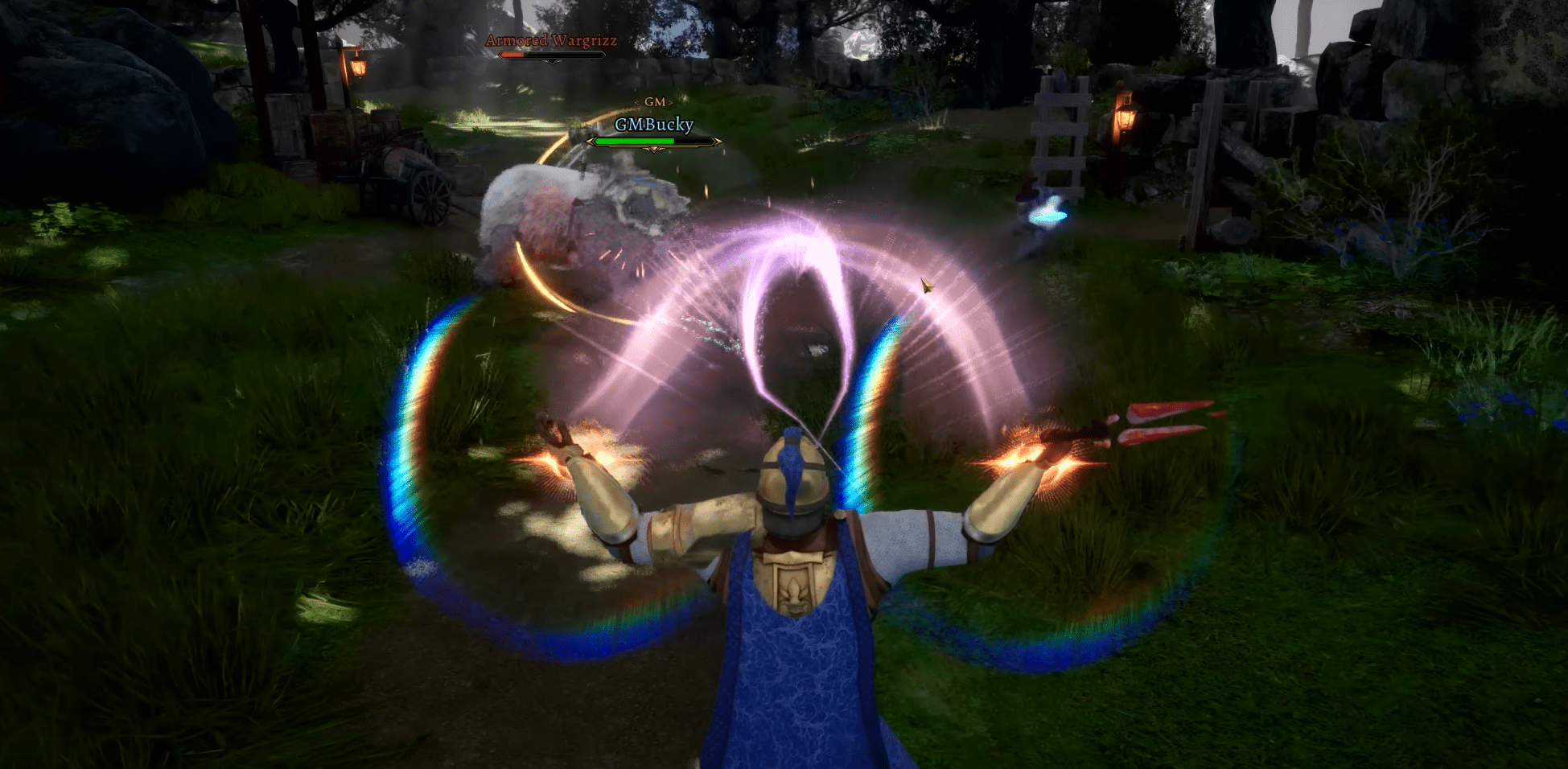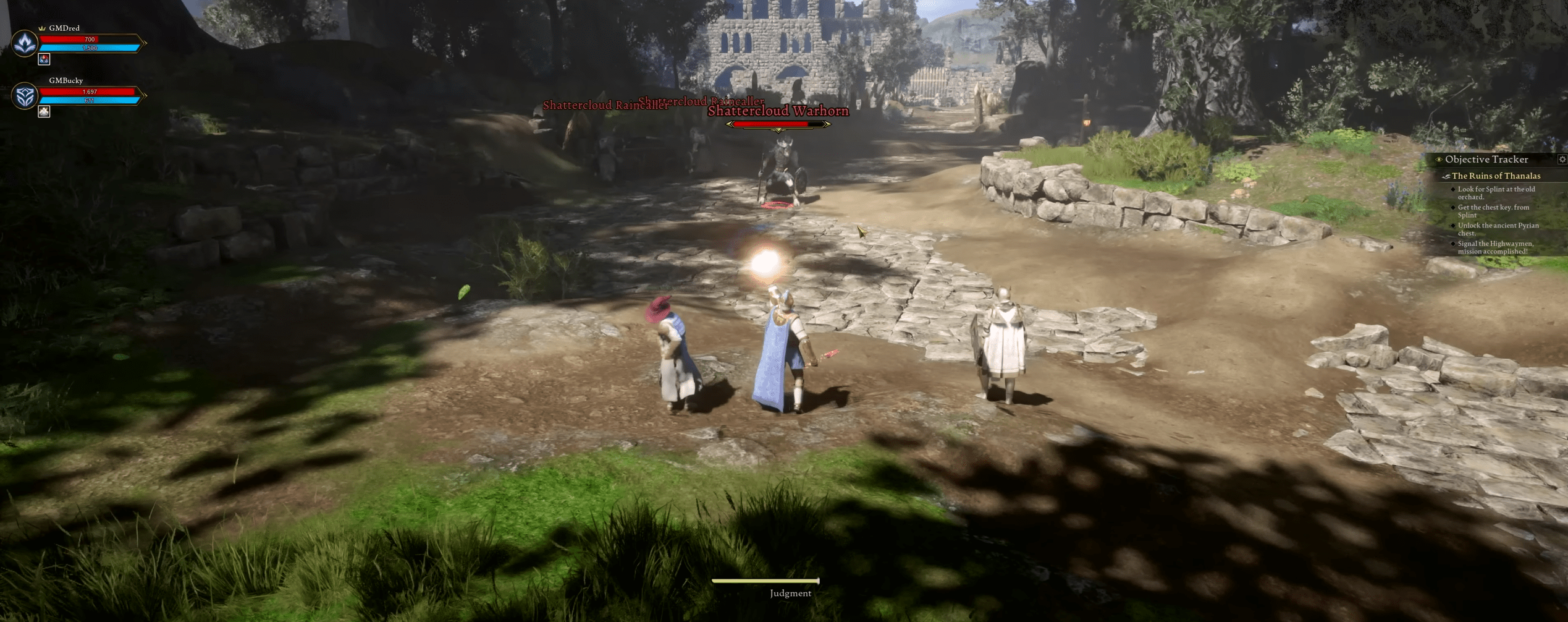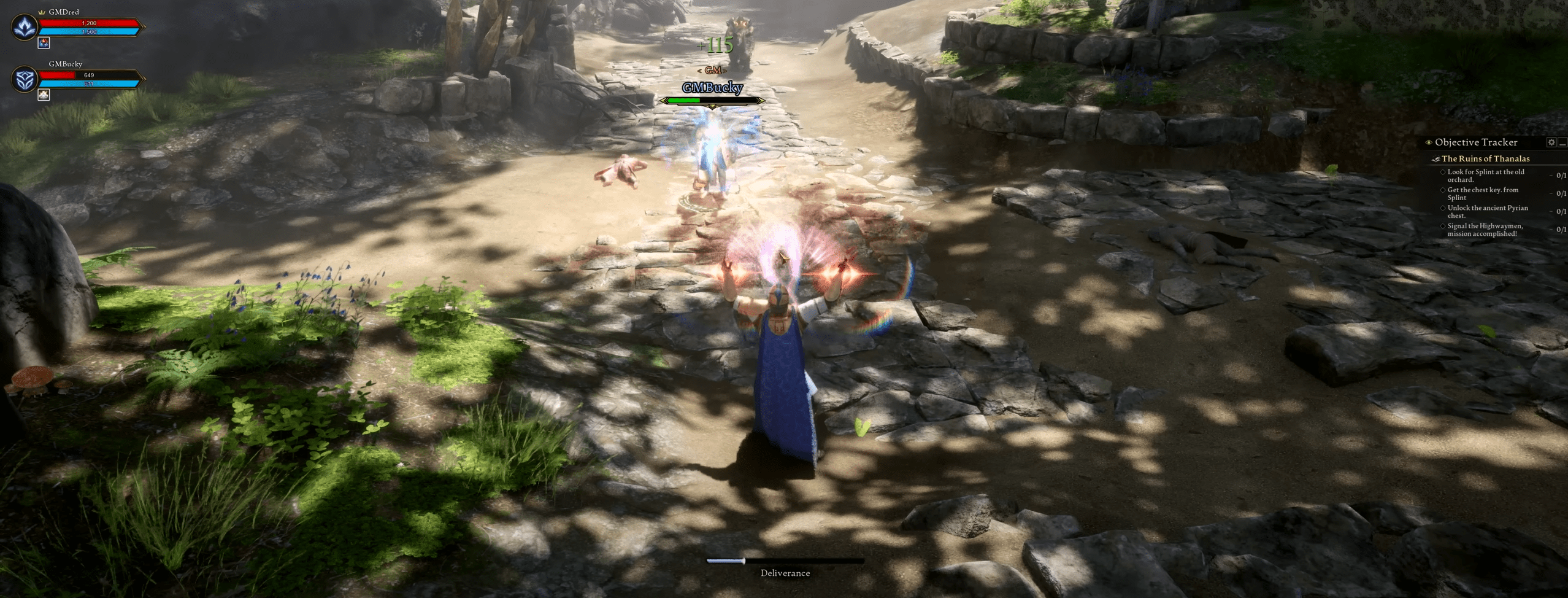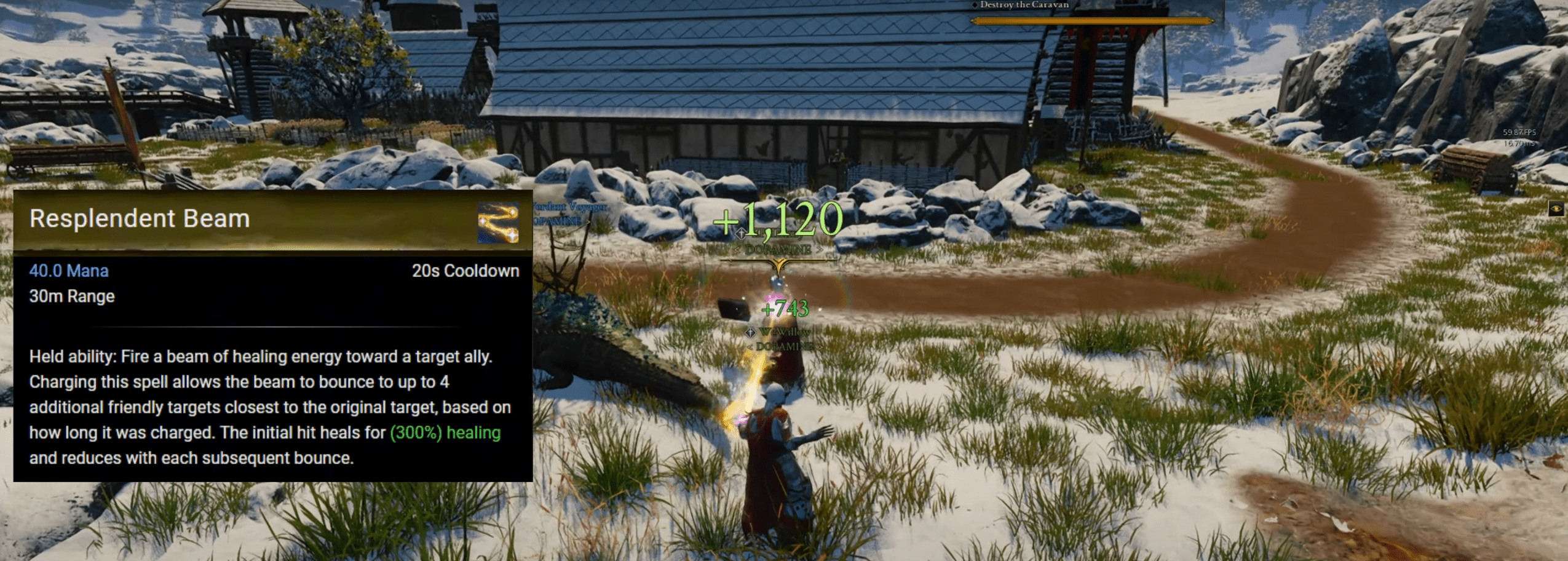Welcome to the Ashes of Creation Cleric guide, where we will explore this archetype and its role in this game.
Ashes runs on a dual-archetype system. You’ll pick your primary role at character creation, then unlock a secondary archetype at level 25 to create one of 64 possible class combinations. Each combo affects how your abilities function and how your role plays out in real scenarios.
This AoC Cleric guide covers everything from healing mechanics and offensive options to augments, class synergies, builds, and gear picks. But more importantly, we’ll see if Cleric can do more than just healing and whether or not it is comfortable to level up solo.
And if you're looking to skip the early grind and jump straight into class experimentation, Skycoach's Ashes of Creation services can help you hit level 25 fast, so you can unlock your secondary archetype and start building your ideal class sooner.
Read our other Ashes of Creation guides:
- Best Classes Tier List
- Best PvE Builds
- Leveling Guide
- Gear Sets Guide
- Mage Guide
- Bard Guide
- Gold Farming Guide
Note: At Skycoach, you can Buy Ashes of Creation Boost at the best prices with fast delivery. Use our special PROMO CODE (in green) hidden in this article for a 20% DISCOUNT.
Ashes of Creation Cleric Overview

Let's start with a general Ashes of Creation Cleric overview — so that you have a clearer idea of what an AoC healer looks like.
For those of you worrying, Clerics in Ashes aren’t passive backline bots. They’re fully capable of leveling solo, holding their own in open-world combat, and even dishing out some serious radiant damage.
So, how to play Cleric in Ashes of Creation? It’s all about balance. You have direct healing, group support, and cleansing tools—but you also get access to damage spells like Smite, Chains of Restraint, and Judgment, making solo play not just possible, but surprisingly efficient. The devs have made it clear: Clerics are meant to be self-sufficient. Whether you're grinding mobs, doing story arcs, or questing through dangerous zones, you won’t be stuck relying on others to carry you.
What makes the Cleric archetype stand out:
- Only archetype that can function as a full-time healer
- Access to AoE heals, shields, buffs, and resurrection spells
- Solid solo damage options with casted nukes, DoTs, and radiant AoEs
- Gains Divine Power through healing and damage, which powers up your big plays
- Doesn’t rely on gods or divine favor—powers come from manipulating The Essence
In other words, Clerics aren’t just support—they’re adaptive spellcasters who can shift between survival, sustain, and offense depending on the situation.
Later sections will break down specific skills, stat builds, weapons, and augments—but if you're looking for a support class that can stand on its own, Cleric is a strong, well-rounded choice.
Cleric Pros and Cons

No matter how powerful a class may look on paper, every archetype in Ashes of Creation comes with trade-offs—and Clerics are no exception. If you’re drawn to the idea of being a magical lifeline for your party, the Cleric offers one of the most versatile support toolkits in the game. But it’s not all radiant damage and resurrection spells—you’ll need to weigh the strengths against the limitations, especially if you’re planning to solo.
Here’s a quick breakdown of the Ashes of Creation Cleric pros and cons to help you decide if this archetype fits your playstyle:
Pros:
- ✅ Best healing and support in the game – Cleric is the only archetype that can serve as a true primary healer, with access to powerful group heals, resurrection, cleansing, shields, and even overhealing mechanics.
- ✅ Surprisingly capable solo play – With skills like Smite, Judgment, and Chains of Restraint, Clerics can dish out respectable radiant damage and hold their own while leveling.
- ✅ Top-tier utility and survivability – Between healing, cleansing, temp HP, and defensive buffs like Barrier, Clerics have excellent tools for surviving dangerous content and keeping allies alive in the chaos.
Cons:
- ❌ High priority target in PvP – Expect to be focused first in group fights. Your value as a healer puts a target on your back, and without strong positioning or peels, you’ll drop fast.
- ❌ Positioning matters – Many heals are directional, charged, or ground-placed, requiring good timing and awareness. You’re not just pressing one button to win.
- ❌ Damage isn’t bursty – While soloing is viable, Clerics don’t kill as fast as pure DPS archetypes. Fights will take longer, especially against tougher enemies or multiple targets.
The Cleric thrives in the hands of a player who enjoys high-impact decision-making and strong team synergy, but still wants the freedom to go it alone when needed. If you’re up for the challenge of keeping everyone alive (yourself included), this archetype definitely delivers.
Cleric Classes

Ashes of Creation uses a dual-archetype system, meaning your final class is formed by combining a primary and secondary archetype. Choosing Cleric as your primary sets the foundation for healing, buffs, and radiant damage. At level 25, you’ll unlock a secondary archetype, allowing you to refine your playstyle even further — whether you’re after more damage, extra survivability, or better group utility. BLOG20
Below is a full list of Cleric-based classes, showing how each secondary archetype shifts the role and feel of the Cleric in combat:
| Class | Secondary Archetype | Class Description |
| Apostle | Tank | A high-durability support that can hold threat and reinforce allies, trading some damage for frontline presence and shielding utility. |
| High Priest | Cleric | The purest healer in Verra. Maximum sustain, AoE healing, and radiant damage potential for those who want to commit fully to the support role. |
| Oracle | Mage | Adds arcane power and elemental flair to the Cleric’s toolkit. Great for ranged damage and magical debuffs while still keeping group healing strong. |
| Protector | Ranger | A mobile, utility-heavy hybrid. Gains better field awareness and positioning tools, with a side of self-healing and ranged utility. |
| Scryer | Bard | Specializes in buffs and regeneration. Perfect for keeping allies alive longer while bolstering their strength mid-fight. |
| Shadow Disciple | Rogue | A sneaky twist on the Cleric. Gains evasive tools and potential burst damage while keeping a support backbone. Think healing with a side of mischief. |
| Shaman | Summoner | Blends radiant healing with summoned utility. Potential to call forth supportive spirits or add DOTs via spectral attacks. |
| Templar | Fighter | Turns the Cleric into a melee-capable brawler with decent sustain. Stronger up close, with improved solo leveling and offensive pressure. |
Every Cleric-based class brings something different to the table, and which one works best for you depends on how you like to play. Whether you want to solo comfortably, heal full-time in dungeons, or support while throwing hands in PvP — there’s a combo that fits your goals. We’ll explore builds and synergies for each class later in the guide.
Cleric Stat Priority
In Ashes of Creation, Clerics are built to heal, support, and still put out a decent amount of Radiant damage when needed. But to make the most of this archetype — especially if you're planning to level solo — you'll want to prioritize stats that enhance your sustain, spell efficiency, and healing output.
Like all classes, Clerics benefit from primary attributes that feed into waterfall stats. These derived stats are what actually boost things like casting speed or mana regen in moment-to-moment gameplay. Below are the core stats that Clerics should focus on — whether you’re healing a party or holding your own in solo content.
Key Stats for Clerics
- Wisdom
Boosts your Magical Casting Speed and Magical Critical Chance — critical for responsive heals and burst damage.
Also improves Magical Evasion, giving you more survivability against enemy casters.
- Mentality
Increases your Max Mana and Mana Regeneration, letting you stay in the fight longer without running dry.
Raises Magic Resist, making you more resilient in both PvE and PvP against magical threats.
- Intelligence
Buffs Magical Power and Magical Accuracy, making your offensive spells (like Smite or Judgment) hit harder and more reliably — especially important if you’re leveling solo.
- Constitution (Optional for survivability builds)
While not a priority for output-focused builds, adding a bit of Constitution boosts Max Health and Physical Mitigation, giving you more breathing room in high-damage encounters.
Stats can be enhanced further with tattoos, gear, enchantments, and socketed items — all of which allow fine-tuning based on your playstyle. If you’re aiming for a healing-heavy support Cleric, Wisdom and Mentality are your go-tos. But if you want to solo effectively or mix in some damage, investing in Intelligence pays off fast.
Later in the guide, we’ll dive deeper into how stat weights shift depending on your chosen class combo (like Oracle vs. Templar), gear sets, and augment options.
Cleric’s Unique Mechanic Explained

One of the most defining features of the Cleric archetype in Ashes of Creation is its unique resource: Divine Power. While most classes manage the usual health and mana bars, Clerics get a third resource that fuels some of their most impactful abilities — and knowing how to manage it well sets a great Cleric apart from a good one.
What is Divine Power?
Divine Power is a yellow bar that builds up over time as you heal allies or deal Radiant damage. However, it only counts effective healing — meaning you can’t just spam heals on full HP targets to cheese it. This system rewards Clerics who are actively contributing in fights, whether they're supporting the group or going solo.
At full capacity, Divine Power also gives you a 10% increased critical chance on healing spells — a nice bonus for both burst heals and sustained support.
How to Use Divine Power
Clerics have two key skills that interact with this mechanic:
- Divine Infusion: Lets you instantly complete the cast time of a spell you’re already channeling. It's perfect for when you need a clutch heal right now, skipping the normal cast time entirely. The more time left on the cast, the more Divine Power it consumes.
- Essence Infusion: This toggle ability lets your next spells consume Divine Power instead of mana or health, letting you cast even when your main resources are drained. If you don’t have enough Divine Power, it reverts to using the original cost.
These abilities make Divine Power a flexible tool for survival and efficiency — especially in high-pressure moments where cast times can get you or your party killed.
Cleric Augments
If you’re picking Cleric as your secondary archetype in Ashes of Creation, you’ll gain access to augments that can significantly shift how your primary class plays — especially when it comes to support and survivability.
Cleric augments come in two main flavors: Life and Death. Each path has its own unique twist on your abilities, whether you're aiming to bolster allies or curse your enemies.
Life Augments
Going down the Life route enhances your ability to heal and support. Some skills will now provide self-healing, while others might offer light healing to nearby allies, even if your base archetype isn’t support-focused. These augments don't make you a full-blown Cleric, but they can give your build a solid dose of sustain — ideal for solo play or hybrid roles.
Death Augments
On the flip side, Death augments lean into dark utility and summoning themes, especially when paired with the Summoner archetype. These augments can change the kind of minions you summon, allowing for things like skeletons and zombies, adding a bit of necromantic flavor to your kit. While this path is less focused on healing, it opens up some interesting control and thematic options for players who want to channel a more ominous style of support.
Cleric Skills

Whether you’re healing a group through brutal boss fights or dishing out radiant justice solo, the Cleric’s toolkit is impressively versatile. In Ashes of Creation, Clerics aren't confined to just babysitting health bars — they’re built with a strong balance of restoration, enhancement, and debilitation, making them effective in a wide range of scenarios.
Below is a list of current Ashes of Creation Cleric skills, combining burst healing, utility, and respectable damage. Expect this list to grow and evolve, but here’s what we know so far:
| Skill | Description |
| Barrier | Sacrifice 25% of your max health to give that amount as temporary health to an ally for 10 seconds. Doesn’t stack. |
| Bless Weapon | Imbues an ally’s weapon with radiant energy. |
| Chains of Restraint | Summons radiant chains at a target location, dealing AoE damage and rooting weakened enemies. |
| Cleansing Wave | Channel a beam of healing that can bounce between allies, healing less with each jump. |
| Communal Restoration | Heals all nearby party members and applies a lingering restoration effect. |
| Condemn | Incapacitates an enemy for 10 seconds. If the target is already conflagrating, it gets stunned instead. |
| Consecrating Wave | Emits a radiant wave that damages enemies, dispels buffs, and applies debuffs to silenced targets. |
| Defiant Light | Applies a defensive buff to an ally. |
| Deliverance | Charges a healing spell that scales in power the longer it's held, up to a strong burst. |
| Divine Flare | Places a healing zone that heals all targets after a short delay, scaling with the number of players affected. |
| Divine Infusion | Consumes Divine Power to instantly finish casting the spell you’re currently channeling. |
| Essence Infusion | Lets your abilities use Divine Power instead of mana or health while active. |
| Flash Cure | Instant heal with 3 charges, usable during other ability animations. |
| Healing Touch | Delivers a large heal to a nearby ally in melee range. |
| Judgment | Heals an ally or deals damage to an enemy depending on the target. If the target is Shaken, the caster heals from the damage dealt. |
| Mend | Fires a quick healing projectile that heals on impact. |
| Purify | Cleanses up to 3 dispellable debuffs from a friendly target. |
| Resplendent Beam | A channeled healing beam that bounces to nearby allies, similar to Cleansing Wave. |
| Resurrect | Revives a fallen ally with 25% of their max health and mana. |
| Smite | Strikes an enemy with radiant damage. If cast in melee range, it’s instant. Burning enemies become Conflagrating. |
| Soothing Glow | Applies a healing-over-time effect. Has 2 charges. |
| Wings of Salvation | Dashes to an ally while applying a buff to both of you on arrival. |
Clerics are built to adapt. You can specialize into full healing, go hybrid with damage and sustain, or even lean more offensively while still offering backup support. With their strong solo capability and meaningful group utility, Clerics remain one of the most flexible archetypes in Ashes of Creation.
Cleric Weapons

When selecting a weapon for your Cleric, your choice should reflect your focus—whether it’s maximizing healing output, managing mana efficiently, or offering supportive damage and crowd control in PvP. The right weapon directly influences your effectiveness due to the way healing and radiant damage scale with magical power. So, here are a few great options for Ashes of Creation Cleric weapons that you should try out:
Primary Weapon Choices
1. Spell Sword (Two-Handed)
- Recommended for PvE and healing-focused Clerics.
- Offers the highest magical power, which translates into stronger healing and radiant damage.
- Preferred over one-handed alternatives due to the value of raw healing output in group play.
2. Mace and Focus (Main Hand + Off-Hand)
- Lower magical power compared to Spell Sword.
- Provides slightly faster cast times, but the tradeoff isn’t generally worth it, as most Cleric spells are instant-cast or benefit more from power than speed.
- Considered a secondary option, mostly viable for solo play or when cast speed is prioritized.
Off-Hand / Ranged Support
3. Wand or Spellbook
- Recommended for ranged radiant applications and supportive damage.
- Allows Clerics to apply burning (for Smite/Condemn combo) or chilling (to support Mage allies).
- Useful in PvP for soft control and synergy, especially when juggling between healing and offense.
Bless Weapon interacts directly with weapon finishers, granting mana regeneration and burning effects. This makes consistent weapon attacks important, even for Clerics primarily focused on healing.
In longer encounters, particularly during boss fights or large mob pulls, maintaining mana regeneration via weapon procs is critical. Ensuring you're using a weapon that synergizes with Bless Weapon can make a measurable difference in your uptime.
Overall, Clerics benefit most from weapons that enhance their healing throughput and sustain, especially in group-based content. While future secondary archetypes may shift these priorities, at the current alpha stage, Spell Sword remains the top recommendation for its raw power and synergy with the Cleric kit.
Cleric Best Gear
In Alpha 2 Phase 3, gearing up as a Cleric is less about chasing static best-in-slot (BiS) setups and more about understanding how gear interacts with your role, content type, and group dynamics. While there’s no hard meta yet, the direction of the current systems already highlights what gear performs best under different circumstances.
The Archetype’s kit focuses on radiant magic, reactive healing, and moderate crowd control, which means you’re looking to amplify magical power and sustain in your Ashes of Creation Cleric best gear. That said, Ashes gives players considerable flexibility, and armor isn’t class-locked. Clerics can wear light, medium, or even heavy gear depending on needs—though how you mix these pieces will impact efficiency and set bonuses.
Suggested Gear Sets for Clerics (Alpha 2 Known Sets)
| Set Name | Type | Use Case | Where It Comes From |
| Steelbloom Mage Set | Light Armor | Core healing in PvE | Drop/crafted gear in Steelbloom |
| Academus Set | Heavy Armor | PvP tankiness | Carphin Tower encounters |
| Carphin Robes | Light Armor | High output healing | Dungeon set from Carphin |
| Bloom Warden | Light Armor | Magic-focused support | Crafting or elite mobs |
| Titanbark | Medium/Heavy Armor | More balanced stats | Drop or crafted progression |
These are a solid starting point for experimentation, especially as gear availability and tuning continue to shift with updates. As always, don’t just chase stats—consider how each set interacts with your skill loadout, the enemies you're facing, and how mobile or defensive you need to be in that context.
These priorities should influence not just armor, but also your accessories and enchants.
Armor Type Choices
Ashes uses a flexible armor system where gear isn't bound to class, but each type provides different tradeoffs:
- Light Armor (Robes): Best for maximizing healing output and magical defense. Ideal for raid or dungeon groups where you're playing pure support.
- Medium Armor (Leather): Offers a blend of defense and utility, good for solo or small-group play where you may take hits. BLOG20
- Heavy Armor (Plate): High physical resistance, lower healing efficiency. Works well in PvP when you need to survive burst damage.
Set bonuses apply when wearing a full armor type, so mixing pieces is a tradeoff. Light gear is the go-to for most healing-focused builds, but a few heavy pieces can improve survivability in PvP without totally sacrificing your potency.
Recommended Weapon and Offhand
The current standout weapon for healing Clerics is the Greatspell Sword, favored for its high magical power even at the cost of slower casts. Pairing it with the right focus item enhances your radiant spells and helps build Divine Power more consistently.
Some setups to consider:
- Greatspell Sword + Wand – Best for pure heal builds, prioritizing radiant spell synergy
- Mace + Spellbook – Faster casting, good for burst healing and PvP escape pressure
- Scepter + Focus – Balanced pick with regen or cooldown-reduction bonuses
Pick the combo that suits your playstyle—whether you want raw healing output, quicker casts, or better mana sustain.
Building for Content Types
Your gear needs will vary based on the content you're focused on. In dungeons or group PvE, prioritize healing throughput and cooldown management. Mana regen becomes a key limiter in longer encounters, so choosing accessories with Mentality or flat regen is critical.
For PvP, build defensively. You’ll want at least partial heavy gear or high-Constitution pieces to avoid being deleted in the first few seconds of a fight. PvP also demands faster access to emergency spells, so anything that lowers cast time or adds instant healing will pull its weight.
If you're solo leveling or duoing, focus more on hybrid sustain. You’ll need a bit of regen, decent damage (via radiant procs), and enough armor to avoid chugging potions every minute. In this case, medium armor with healing trinkets might be the sweet spot.
Gear Loadouts and Switching
Ashes supports loadout swapping outside of combat, so it’s smart to maintain at least two core setups:
- Group PvE Loadout: Full light armor, spellbook or wand focus, gear enchanted for regen and magical power
- PvP Loadout: Mixed light/heavy, weapon with instant-cast support, gear with health boosts or resistances
- Solo Loadout: Medium armor, balanced stats, some self-healing on gear or passives
You can quickly toggle between these with a hotkey, which becomes especially useful when bouncing between world PvP and group content.
Ultimately, the best gear for a Cleric comes down to context. There’s no universal BiS loadout—but there is a right tool for every job. Whether you’re shielding allies in a siege or topping off your party in a boss room, tailoring your gear to the encounter will always outperform cookie-cutter builds. As the systems continue to evolve through Alpha, staying flexible and gear-aware will be your biggest advantage.
Best PvE Cleric Build

This Ashes of Creation Cleric best PvE build is designed to maximize group sustain, cooldown efficiency, and radiant-based healing throughput—making you the backbone of any dungeon or raid group. The goal here is simple: keep your team alive through smart skill rotations, mana efficiency, and burst healing when it counts.
- Primary Archetype: Cleric
- Secondary Archetype: TBD (Alpha 2 Phase 3 doesn’t support secondary archetypes yet)
- Playstyle: High-efficiency group healer with radiant synergy, reactive tools, and AoE coverage
Key Skills to Focus:
- Judgment – Your strongest direct heal or radiant damage spell (dual use based on target)
- Flash Cure – Instant healing, usable during casts or channeling (always keep charges)
- Communal Restoration – AoE heal + shield effect; spam on cooldown in group content
- Deliverance – High-efficiency hold-cast, scales with missing health (mana saver)
- Soothing Glow – HoT effect that can be stacked on tanks or rotated across allies
- Bless Weapon – Critical for mana regen; cast on auto-attacking allies or self
- Defiant Light – Pre-emptive safety net to prevent death on tanks
- Divine Flare (Restorative) – AoE burst heal with radiant synergy
Gear Focus:
- Greatspell Sword + Wand – Best combo for maximizing radiant healing power
- Light Armor Sets (full set bonus):
- Steelbloom Mage Set (early/mid-game)
- Carphin Robes or Bloom Warden (for high throughput healing)
- Enchants: Focus on mana regen, healing power, or cooldown reduction
Rotation Tips:
Start every pull by applying Bless Weapon on a tank or frequent striker. If it’s a big pull, open with Barrier (if specced) into Defiant Light to cushion burst. Drop Divine Flare early if multiple allies will take damage and follow with Communal Restoration for AoE sustain. Use Flash Cure mid-cast to save someone in danger. Deliverance is best held for a tank at 40% HP or lower—it’s cheap and strong when timed right.
Don’t forget to auto-attack for mana regen procs with your finisher when safe.
With this setup, you can manage massive pulls, minimize mana downtime, and keep your group going without relying on potion spamming. Smart cooldown use and timely HoTs are your bread and butter.
Best PvP Cleric Build
This Ashes of Creation Cleric best PvP build focuses on survivability, crowd control, and reactive healing in high-pressure environments. Clerics are often the prime target in PvP, so this build is about staying alive while keeping your team on its feet—especially in skirmishes and larger battlefield scenarios.
Primary Archetype: Cleric
Secondary Archetype: TBD (Phase 3 still restricts secondary choice)
Playstyle: Mobile, defensive healer with CC tools, clutch healing, and self-sustain through radiant effects
Key Skills to Focus:
- Flash Cure – Instant heal; use while silenced, casting, or running
- Defiant Light – Your "don’t die" button for allies—time it before a big hit lands
- Barrier – Costs health, not mana; great for starting fights or surviving focus
- Condemn – Strong single-target CC, becomes a 4-sec stun if used after Smite
- Divine Flare (Retribution) – AoE silence; drop it into caster clumps or push points
- Wings of Salvation – Mobility tool and soft peel to reach teammates under pressure
- Purify – Removes debuffs like poison, burn, or slows; important vs. DoT builds
- Smite – Radiant damage and CC trigger (pairs well with Condemn)
Gear Focus:
- Mace + Spellbook or Scepter + Focus – faster cast speed and better defensive scaling
- Mixed Armor Setup:
- 3–4 pieces of heavy (Academus) for physical mitigation
- 4–5 pieces of light for keeping set bonus active or radiant power
- Enchants: Prioritize HP, CC reduction, or instant-cast cooldowns
Tactics and Tips:
Pre-cast Defiant Light on yourself or your frontliner before a dive starts. Keep Flash Cure off cooldown and ready to pop while stunned or mid-cast. Use Condemn + Smite together for chain CC on melee threats. When enemy casters start channeling, toss a Divine Flare (Retribution upgrade) into their clump to silence them. Use Barrier smartly before combat to soak incoming damage and save mana.
You are a high-value target in PvP. Stay mobile with Wings of Salvation and communicate when using Purify to cleanse your frontliners. Always save at least one Flash Cure for yourself.
This build turns the Cleric into a battlefield stabilizer—difficult to kill, disruptive to enemy plays, and always in the right place at the right time.
Cleric Rotations
Clerics rely heavily on sequencing radiant abilities, layering effects, and adapting based on party needs or enemy pressure. With Divine Power generation baked into your kit and strong cast time management tools, well-timed rotations can be the difference between a clean fight and a group wipe.
Below are two core Ashes of Creation Cleric rotations that will serve you well in both PvE and PvP. They’re designed for Phase 3 content where healing output, crowd control, and clutch saves matter more than ever.
Group PvE Healing Rotation (Boss Pull or Multi-Mob Pack)
Bless Weapon → Barrier → Defiant Light → Soothing Glow ×2 → Divine Flare → Communal Restoration → Men (spread to wounded allies) → Deliverance (if tank is low) → Judgment (with Divine Infusion if available)
This rotation sets the tempo for high-sustain healing with layered effects and radiant synergy. Here's the breakdown:
- Bless Weapon goes first to begin stacking mana regen early, either on yourself or a fast-attacking ally.
- Barrier gives immediate temporary health without costing mana—perfect for starting a pull or reacting to burst.
- Defiant Light creates a safety net on your tank or primary aggro target; if they're about to drop, they won’t.
- Soothing Glow applies your main HoT—use it twice to stack duration on the tank or spread it between tank and off-healer if needed.
- Divine Flare with its Restorative upgrade offers a solid AoE burst heal; drop it when incoming damage is expected.
- Communal Restoration follows up with party-wide healing and shields, excellent during burst phases.
- Men should be used rapidly on 2–3 allies to top off stragglers or continue healing across the group.
- Deliverance is your hold-cast big single-target heal—ideal for when the tank dips below 40%.
- Judgment (with Divine Infusion if available) gives you an instant cast, full-power heal. Always save for clutch recovery. BLOG20
This rotation allows you to deal with large pulls or dungeon mechanics without gassing your mana bar too quickly. You’re layering pre-emptive, reactive, and radiant healing tools for maximum uptime.
Reactive PvP Support Rotation
Wings of Salvation → Flash Cure → Barrier → Defiant Light → Smite → Condemn → Purify → Judgment
This sequence is designed for when you’re being focused in PvP and need to stabilize yourself or peel for teammates.
- Wings of Salvation is your gap-closer and escape tool—use it to reach a teammate or break distance from enemies.
- Flash Cure buys time with a quick self-heal or teammate top-off while repositioning or casting.
- Barrier soaks a large hit at the cost of your HP. Use it just before enemy burst windows.
- Defiant Light on yourself or your carry keeps them from dying outright if a big nuke is coming.
- Smite → Condemn is your CC chain. If the enemy is burning, Condemn becomes a 4-second stun. This combo breaks momentum hard.
- Purify is key if you've been hit with a slow, root, or DoT—use it to stay mobile and continue healing.
- Judgment is your final play—it can be healing or radiant damage depending on who you target. If you have Divine Infusion, it's an instant cast.
This rotation prioritizes survivability, team peel, and disruption. You're not just healing here—you’re preventing deaths, cleansing CC, and forcing enemies to back off.
More advanced Clerics will eventually develop multiple variations of these depending on whether they’re in raids, skirmishes, or world PvP—but these two give you a strong foundation to adapt from.
Cleric Leveling
Leveling a Cleric in Ashes of Creation Alpha 2 Phase 3 is all about striking a balance between healing output, mana efficiency, and survivability. Whether you're supporting a group, duoing with a damage dealer, or soloing tougher mobs, your goal is to stay on top of your healing role without becoming a liability due to mana burn or poor positioning. While Clerics aren’t damage-focused, their utility and sustainability make them one of the most consistent archetypes to level—especially in group content.
Early Progression (Levels 1–5)
In the first few levels, you’ll be leaning on a combination of Men and Judgment. Men handles basic healing needs, while Judgment acts as both a strong single-target heal or a damaging spell depending on target. At this stage, it’s important to conserve mana while learning timing and positioning—Cleric healing isn't purely spammy, it’s reactive and rotational.
Flash Cure comes online shortly after and is a key pickup for its instant cast and low cooldown. It allows you to heal without interrupting longer casts or while regaining mana through other mechanics like food or resting.
Midgame Milestones (Levels 6–10)
By level 6, you unlock the second row of abilities and gain access to Resurrect, which already gives Clerics a core support function in dungeon groups. Around this time, Defiant Light becomes your go-to preventive healing spell—healing over time with a death-prevention mechanic if timed correctly. At level 7, Bless Weapon enters the rotation, granting you or a teammate consistent mana regeneration with every weapon combo finisher. Keeping this active on someone who auto-attacks frequently (like a tank or ranger) becomes second nature.
When you hit level 9, you’ll get Divine Flare, your first area-of-effect healing ability. While potent, it splits its healing among all players in the area, so it's crucial to communicate with your group: only those who need healing should step inside. Otherwise, its effectiveness plummets.
At level 10, Soothing Glow gets its much-needed passive upgrade, allowing you to cast it multiple times on the same target, extending its healing duration and making it a true HoT option worth weaving into longer fights.
Group vs. Solo Considerations
If you’re leveling as part of a full group, you can play a more traditional support role—focusing on uptime for healing-over-time spells, prepping for burst phases with Barrier, and using Deliverance for its high scaling and mana efficiency when allies dip below 50%. When you’re solo or duoing, your build should be more hybrid-oriented: take medium armor, invest in mana sustain through Bless Weapon, and rely on Smite or Judgment (damage mode) for your limited offensive contribution.
You’ll also need to keep your mana pool in check. Clerics can easily overcast in low-stakes fights and end up tapped out for when things actually get dangerous. Using Deliverance as a held heal lets you time your healing and save resources by avoiding over-healing.
Adapting as You Level
As you reach higher levels and unlock more of the skill tree, your rotation becomes more complex but also more rewarding. Communal Restoration adds another AoE tool with a bonus temporary shield, and Consecrating Wave offers offensive pressure with group-wide healing utility. Around level 14, it's also advised to temporarily drop Plentiful Men and shift focus to more AoE tools for large pulls, then reallocate points later as needed.
Don’t forget: your build doesn’t need to be static. With gear loadouts and respecs available, your Ashes of Creation Cleric leveling experience can—and should—adapt based on whether you’re in dungeons, PvP zones, or exploring solo. Being a flexible support makes you invaluable, and mastering that flexibility early on will pay off in every group you join.
Cleric Tips and Tricks
Cleric has a deep healing kit, but the difference between a solid player and a great one often comes down to small optimizations. These AoC Cleric tips are based on in-game behavior, not theory. They're the kind of adjustments that can make your healing smoother, more efficient, and way more clutch when it matters.
1. Use Barrier proactively, not reactively
Barrier doesn’t cost mana—it costs a chunk of your health. That makes it one of your most efficient tools, especially at the start of a fight. Use it right before a tank engages or a party member takes a predictable hit. Trading 25% of your HP for 25% temporary HP on them buys time and saves mana in the long run. Don’t wait for someone to be in danger—Barrier is best when used preemptively.
2. Divine Infusion isn’t just for Judgment
While most Clerics instinctively save Divine Infusion for an instant Judgment, it has huge value when comboed with Deliverance or Purify during emergencies. A clutch instant Deliverance can full-heal a tank, and using Divine Infusion to instantly remove poisons or debuffs in mechanics-heavy encounters will save more lives than a late AoE heal ever could.
3. You can heal while casting other spells
Flash Cure can be used during other spell activations—including while eating or casting longer abilities like Judgment or Deliverance. Mastering this lets you weave in quick heals without interrupting your main cast rotation. Use this mechanic to get value out of every global, especially when someone dips unexpectedly and you don’t want to cancel your current cast.
4. Communal Restoration isn’t just for healing
Communal Restoration applies temporary HP and a HoT—even if your team is at full health. Use it early in a fight to layer mitigation and regen on the group, especially before heavy AoE phases. It doesn’t just react to damage, it helps absorb and recover from it faster. Treat it like a soft shield rather than a panic heal.
5. Don’t split Divine Flare healing
Divine Flare splits its healing among all players in its radius. If five people stand in it, no one gets full value. Use voice or pings to train your group to only stand in it when needed. For max output, drop it directly under the tank or a single injured target. In PvP, you can also combine it with Barrier on yourself and stand in your own Flare for surprising durability.
Most players focus on raw healing numbers, but it’s these kinds of smart plays that really keep your group alive and let you shine in both PvE and PvP.
Conclusion
Cleric is shaping up to be one of the most rewarding support archetypes in Ashes of Creation, thanks to its flexible kit, high-impact healing, and tactical utility. Whether you’re keeping your group alive through massive raid pulls or clutch-saving a teammate in PvP, Cleric has the tools—if you know how to use them.
The class rewards planning, awareness, and knowing when to go all-in. With strong scaling, access to powerful radiant magic, and the ability to tailor your gear and rotation to the situation, Cleric is anything but a one-button healer. With the right build, solid gear choices, and a few smart tricks, you’ll be the backbone of your group and the reason they walk away alive.
F.A.Q.
Is Cleric good in Ashes of Creation?
Yes, Cleric is the primary healing archetype and currently the strongest support class. It’s essential in any group and offers powerful healing, crowd control, and utility.
What is the best Cleric build in Ashes of Creation?
There’s no single best build, but PvE Clerics usually favor high output radiant healing, while PvP Clerics lean into survivability and instant-cast utility. Builds vary based on content and group needs.
What does Cleric do in Ashes of Creation?
Clerics focus on healing, cleansing, shielding, and reviving allies. They also provide buffs, crowd control, and limited radiant damage support.
What stats should a Cleric have in Ashes of Creation?
You should prioritize stats differently based on the type of content you wish to do:
- PvE: Intelligence > Wisdom > Mentality > Constitution
- PvP: Constitution > Intelligence > Mentality > Wisdom
What are the best weapons for Cleric in Ashes of Creation?
Use different weapon types for different situations. For example:
- Greatspell Sword + Wand for high healing output
- Mace + Spellbook for faster casting and PvP utility
- Scepter + Focus for regen or cooldown benefits
Is Cleric good for fast leveling in Ashes of Creation?
Cleric isn’t the fastest solo leveler, but it excels in group or duo play. With smart gear and skill picks, it can sustain long fights and handle harder mobs early on.
What weapon should Cleric use in Ashes of Creation?
Pick based on your build:
- Greatspell Sword for raw power
- Wand or Spellbook for utility
- Mace for cast speed
All work depending on your role and focus
What are Cleric’s best skills in Ashes of Creation?
Some of the top skills include:
- Judgment (burst heal or damage + CC synergy)
- Flash Cure (instant cast emergency heal)
- Deliverance (mana-efficient channel heal)
- Barrier (health-based shield)
- Communal Restoration (AoE heal with temp HP)
- Divine Flare (situational AoE + CC option)

















